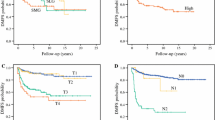Abstract
The purpose of this study was to investigate the prognostic factor in salivary gland carcinoma patients. Clinical and pathological data of 211 consecutive patients who treated with curative intent were analyzed. The overall survival (OS) rate, local control rate, and distant metastasis rate were calculated. To examine a prognostic factor in salivary gland carcinoma patients, a multivariate analysis was performed. The 5-year-OS rate was 84.0%, and 10-year was 69.2%. The 5-year-local control rate was 84.6%, and 10-year was 70.1%. The 5-year-distant metastasis rate was 16.9%, and 10-year was 21.1%. In a multivariate analysis, the OS rate was affected by pN(+), high-grade malignancy, and primary tumor size. The local control was affected by the primary tumor size, high-grade malignancy, and the status of the surgical margin. The primary tumor size and pN(+) were associated with the distant metastasis. The results of this study suggested that pN(+), malignancy grade, primary tumor size, and the margin status might affect the prognosis of salivary gland carcinoma patients. Postoperative radiotherapy and adjuvant chemotherapy were suggested the possibility of contribution to the good prognosis of salivary gland carcinoma patients.






Similar content being viewed by others
References
Ostman J, Anneroth G, Gustafsson H, et al. Malignant salivary gland tumours in Sweden 1960–1989—an epidemiological study. Oral Oncol. 1997;33:169–76.
Pinkston JA, Cole P. Incidence rates of salivary gland tumors: results from a population-based study. Otolaryngol Head Neck Surg. 1999;120:834–40.
Sun EC, Curtis R, Melbye M, et al. Salivary gland cancer in the United States. Cancer Epidemiol Biomark Prev. 1999;8:1095–100.
Koivunen P, Suutala L, Schorsch I, et al. Malignant epithelial salivary gland tumors in northern Finland: incidence and clinical characteristics. Eur Arch Otorhinolaryngol. 2002;259:146–9.
Speight PM, Barrett AW. Salivary gland tumours. Oral Dis. 2002;8:229–40.
Barnes L, Eveson JW, Reichart P, et al. Head and neck tumors. World Health Organization classification of tumours. Lyon: IARC; 2011.
Renehan AG, Gleave EN, Slevin NJ, et al. Clinico-pathological and treatment-related factors influencing survival in parotid cancer. Br J Cancer. 1999;80:1296–300.
Teo PM, Chan AT, Lee WY, et al. Failure patterns and factors affecting prognosis of salivary gland carcinoma: retrospective study. Hong Kong Med J. 2000;6:29–36.
Terhaard CH, Lubsen H, Van der Tweel I, et al. Salivary gland carcinoma: independent prognostic factors for locoregional control, distant metastases, and overall survival: results of the Dutch head and neck oncology cooperative group. Head Neck. 2004;26:681–992.
Mücke T, Robitzky LK, Kesting MR, et al. Advanced malignant minor salivary glands tumors of the oral cavity. Oral Surg Oral Med Oral Pathol Oral Radiol Endodontol. 2009;108:81–9.
Speight PM, Barrett AW. Prognostic factors in malignant tumours of the salivary glands. Br J Oral Maxillofac Surg. 2009;47:587–93.
Lloyd S, Yu JB, Ross DA, et al. A prognostic index for predicting lymph node metastasis in minor salivary gland cancer. Int J Radiat Oncol Biol Phys. 2010;76:169–75.
Kakarala K, Bhattacharyya N. Survival in oral cavity minor salivary gland carcinoma. Otolaryngol Head Neck Surg. 2010;143:122–6.
Larsen SR, Bjørndal K, Godballe C, et al. Prognostic significance of Ki-67 in salivary gland carcinomas. J Oral Pathol Med. 2012;41:598–602.
Bjørndal K, Krogdahl A, Therkildsen MH, et al. Salivary gland carcinoma in Denmark 1990–2005: outcome and prognostic factors. Results of the Danish Head and Neck Cancer Group (DAHANCA). Oral Oncol. 2012;48:179–85.
NCCN Clinical Practice Guidelines (NCCN Guidelines®) head and neck cancers version 2. 2016. https://www.nccn.org/professionals/physician_gls/pdf/head-and-neck.pdf. Accessed 20 Dec 2016.
Edge SB, Byrd DR, Compton CC, et al. AJCC cancer staging manual. 7th ed. New York: Springer; 2010.
Oken MM, Creech RH, Tormey DC, et al. Toxicity and response criteria of the Eastern Cooperative Oncology Group. Am J Clin Oncol. 1982;5:649–55.
National Cancer Instuitute. Salivary gland cancer treatment—for health professionals (PDQ®). http://www.cancer.gov/types/head-and-neck/hp/salivary-gland-treatment-pdq/#link/_6. Accessed 20 May 2015.
Watabe Y, Mori T, Yoshimoto S, et al. Copy number increase of ACTN4 is a prognostic indicator in salivary gland carcinoma. Cancer Med. 2014;3:613–22.
Lagha A, Chraiet N, Ayadi M, et al. Systemic therapy in the management of metastatic or advanced salivary gland cancers. Head Neck Oncol. 2012;4(4):19. doi:10.1186/1758-3284-4-19.
North CA, Lee DJ, Piantadosi S, et al. Carcinoma of the major salivary glands treated by surgery or surgery plus postoperative radiotherapy. Int J Radiat Oncol Biol Phys. 1990;18:1319–26.
Terhaard CH, Lubsen H, Rasch CR, et al. The role of radiotherapy in the treatment of malignant salivary gland tumors. Int J Radiat Oncol Biol Phys. 2005;61:103–11.
Mendenhall WM, Morris CG, Amdur RJ, et al. Radiotherapy alone or combined with surgery for salivary gland carcinoma. Cancer. 2005;103:2544–50.
Author information
Authors and Affiliations
Corresponding author
Ethics declarations
Conflict of interest
The authors declare that they have no conflict of interest.
Rights and permissions
About this article
Cite this article
Yamada, Si., Kurita, H., Kamata, T. et al. Significant prognostic factors affecting treatment outcomes of salivary gland carcinoma: a multicenter retrospective analysis. Odontology 106, 96–102 (2018). https://doi.org/10.1007/s10266-017-0318-1
Received:
Accepted:
Published:
Issue Date:
DOI: https://doi.org/10.1007/s10266-017-0318-1




